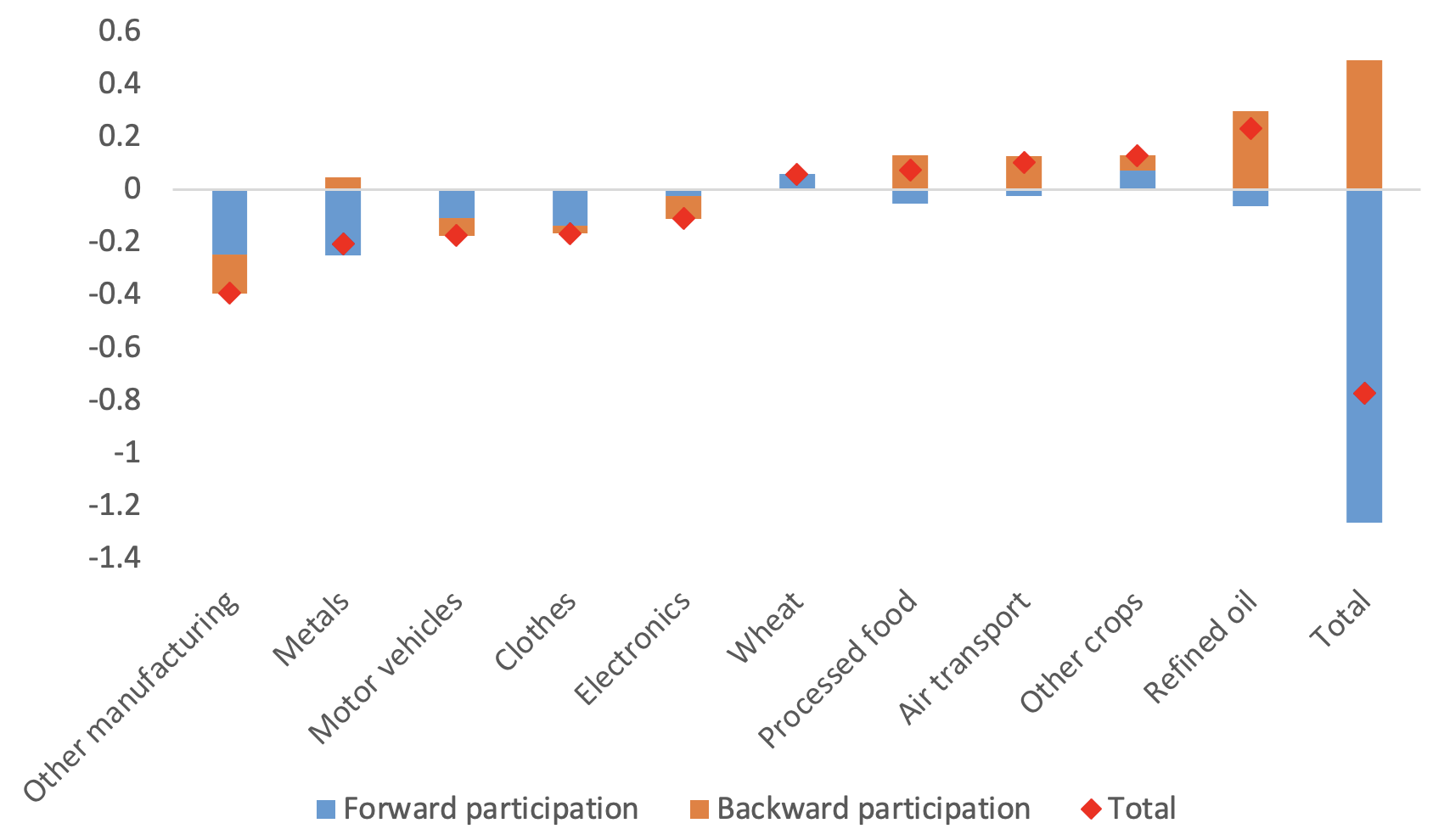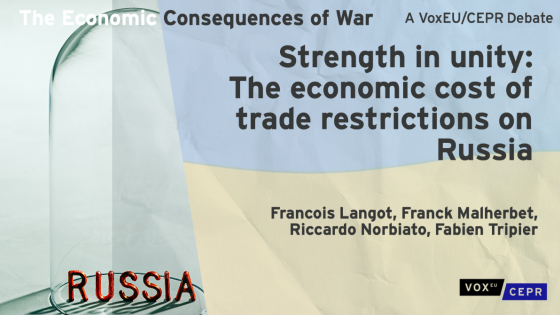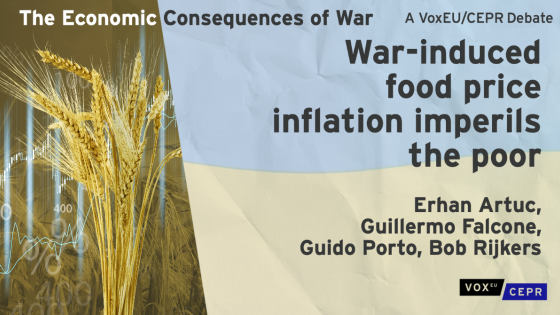The Russian invasion of Ukraine is disrupting global supplies of essential commodities, pushing prices higher, slowing trade, and driving down incomes. Russia and Ukraine together account for about a quarter of global wheat exports and 14% of corn shipments (Figure 1). Ukraine produces half of the world’s sunflower oil, while Russia is one of the world’s foremost energy suppliers. As the Black Sea region is also a large exporter of fertilisers, the resulting shortages and price increases could translate into negative impacts on crop yields in many regions (FAO 2022).
Figure 1 Russia and Ukraine’s global shares of key commodity exports in 2019 (%)
Source: UN Comtrade database (https://comtrade.un.org/).
Developing countries that are highly dependent on food and energy imports are the most vulnerable. Nicaragua, for example, buys 89% of its wheat from Russia and Ukraine; the figure for the Republic of Congo is 67%; and for Egypt it is 46%. Russia supplies 94% of Algeria’s coal and the same share of Kyrgyzstan’s natural gas.
Large energy and agricultural exporters could benefit from commodity supply disruptions, partially replacing lower exports from Ukraine and Russia. The conflict would also lead to a reshaping of global value chains (GVCs). But what countries would be impacted the most? Who would gain from the conflict and how would Russian invasion of Ukraine impact global trade and production around the world?
In a new paper (Chepeliev et al. 2022a), we attempt to answer these questions. Following an approach outlined in Chepeliev et al. (2022b), we combine a state-of-the-art global model, ENVISAGE (van der Mensbrugghe 2019), with the GTAP multi-region input-output database (Carrico et al. 2020). We further simulate the impact of disruptions to agricultural and energy markets caused by the conflict and resulting selected sanctions against Russia.
Food and energy price shocks reduce global trade, but benefit selected exporters
While modelled disruptions reduce volumes of global trade by around 1% or 0.3% as a share of GDP, higher commodity prices create incentives for selected exporters to expand production and partially replace exports from the Black Sea region (Figure 2). Wheat exports from Western Europe, the Europe and Central Asia (ECA) region, the US, and India expand the most. Exports of other crops (close substitutes of wheat) from Turkey, China, Brazil, India, and the US also increase. An even larger expansion in exports is observed for large fossil fuel producers in the Middle East and North Africa (MENA), ECA, sub-Saharan Africa (SSA), and Latin America and Caribbean (LAC) regions (Figure 2).
With higher energy prices, production of energy-intensive and trade-exposed (EITE)1 goods becomes much more expensive, leading to a global decline in exports of around 1%. Exports of non-energy intensive manufacturing sectors and services also fall as consumption shifts towards food, energy, and transport, for which demand is quite inelastic (Figure 2).
Figure 2 Change in exports as a share of real GDP in the reference year (%)
Source: Estimated using ENVISAGE model.
There are winners and losers
With supply disruptions and increasing commodity prices, global income falls by 0.7%, with low- and middle-income countries losing 1% and high-income countries seeing a 0.6% decline (Figure 3). On average, half of the reduction in income comes from increasing energy prices, while the other half is driven by sanctions and disruptions to agricultural supply. The contribution of these two channels varies across regions. In high-income countries, income reductions are largely driven by rising energy prices, while for low- and middle-income countries the major part of the shock is associated with spikes in food prices.
Results also suggest that net importers of energy and agricultural commodities suffer the most, with real incomes in Turkey dropping by 1%, in Thailand by 0.9% percent, and in India and South Africa by 0.6% (Figure 3). Large energy and agricultural producers could benefit from terms of trade gains and see their incomes expanding, with MENA being at the top of this list (Figure 3). This is the result of a combination of rising energy prices and substitution of supply from the Black Sea region. The first channel is of particular importance as, at the time of writing this column, OPEC countries have not announced any plans to expand supply and continue to benefit from rising oil rents. Other net energy exporters, such as Nigeria and Mexico, also see their real income increase (Figure 3).
Figure 3 Change in real income in selected countries and regions (%)
Source: Estimated using ENVISAGE model.
Increasing costs of crops and energy coming on top of the already elevated commodity prices will add additional strain especially on the poorest households in developing countries (Artuc et al. 2022). The lowest-income households spend on average 54% of their consumption expenditures on food, 7% on energy, and 4% on transport.2
High value-added manufactured goods become less integrated into GVCs
Rising agriculture and fossil fuel prices could lead to major restructuring of GVCs (Korn and Stemmler 2022). Consumers now spend more money on food and energy, while the demand for less essential, higher-value manufactured goods decreases. This trend is also reflected in the restructuring of trade flows – in value terms, the share of agriculture and energy commodities in global trade increases, while the share of light manufacturing falls. This composition effect implies that producers of computers, electronics, and transport equipment are less integrated into GVCs, in many cases leading to an overall reduction in those countries’ GVC participation rates.
The latter trend is observed even in some commodity-rich exporters, such as Europe and Central Asia (Figure 4). While exports of agricultural and energy commodities from the region expand and corresponding sectors become more involved in GVCs, their initial participation rates are relatively low compared to high-valued manufacturing goods. A reduction in the GVC participation rates for higher-value and more GVC-integrated goods outweighs the impacts of expanding energy and agricultural trade, meaning the region is less integrated in GVCs (Figure 4). Whether a robust estimated trade reallocation effect will remain after the end of the conflict largely depends on the duration of distortion (Korn and Stemmler 2022).
Figure 4 Change in GVC participation in for Europe and Central Asia, selected sectors (percentage points)
Notes: Forward GVC participation = Domestic value added embodied in third country exports (% of exports). Backward GVC participation = imported inputs in exports (% of exports).
Source: Authors’ estimates using Envisage model.
Policy implications
The war in Ukraine is a dire human tragedy for the people of Ukraine. It also has major implications for the world economy. In this column, we show that due to sharply rising commodity prices, net agricultural and energy importers in the developing world are particularly vulnerable. To mitigate the potential longer-term consequences of the war, several policy steps should be considered.
First, the magnitude of adverse socioeconomic impacts of the war largely depend on the future dynamics and duration of the conflict. Broadening sanctions would help to increase the economic pressure on Russia. Introducing a ban on energy imports (Chepeliev et al. 2022c) and an embargo on Russian capital goods (van Bergeijk 2022) could serve such a purpose.
Second, even if an embargo on energy imports is not imminent, the demand-side policy measures aimed at reducing fossil fuel use and promoting substitution toward alternative energy sources should be implemented (Bachmann et al. 2022). One example of such proactive policies is incentives to switch to electric vehicles through subsidies (Arezki and Nysveen 2022).
Third, with rapidly increasing food prices, some countries might consider imposing agricultural trade restrictions to protect domestic consumers. Such actions should be avoided as they are likely to further jeopardise global food security (Ruta et al. 2022).
Finally, the consequences of the war in Ukraine have already put a disproportionate pressure on lower-income households in developing countries, who spend a large share of their budget on food and energy. Buffering the impacts on poor households via targeted support measures, such as direct lump-sum payments, is a crucial step to ease the burden on the most vulnerable.
Authors’ note: We would like to acknowledge important inputs from Mike Nyawo, Israel Osorio-Rodarte and Chris Wellisz. We are grateful to Mona Haddad, Aaditya Mattoo, Antonio Nucifora, Michele Ruta and Dominique van der Mensbrugghe for their comments and suggestions. The findings, interpretations, and conclusions presented in this column do not necessarily reflect the views of the World Bank, the Executive Directors of the World Bank or the governments they represent.
References
Arezki, R and P M Nysveen (2022), “Ukraine invasion: From oil sanctions to accelerating the energy transition”, VoxEU.org, 01 April.
Artuc, E, G Falcone, G Porto and B Rijkers (2022), “War-induced food price inflation imperils the poor”, VoxEU.org, 01 April.
Carrico, C, E Corong and D van der Mensbrugghe (2020), “The GTAP version 10A Multi-Region Input Output (MRIO) Data Base”, GTAP Memorandum 34, Center for Global Trade Analysis, Purdue University.
Chepeliev, M, M Maliszewska and M Seara e Pereira (2022a), “Effects on trade and income of developing countries”, in M Ruta (ed.), The Impact of the War in Ukraine on Global Trade and Investment, World Bank Trade Investment and Competitiveness Report.
Chepeliev, M, M Maliszewska, I Osorio-Rodarte, M F Seara e Pereira and D van der Mensbrugghe (2022b), “Pandemic, Climate Mitigation, and Re-Shoring: Impacts of a Changing Global Economy on Trade, Incomes, and Poverty”, Policy Research Working Paper 9955, World Bank.
Chepeliev, M, T Hertel and D van der Mensbrugghe (2022c), “Cutting Russia’s fossil fuel exports: Short-term pain for long-term gain”, VoxEU.org, 09 March.
FAO (2022), “The importance of Ukraine and the Russian Federation for global agricultural markets and the risks associated with the current conflict”.
Korn, T and H Stemmler (2022), “Russia's war against Ukraine might persistently shift global supply chains”, VoxEU.org, 31 March. https://voxeu.org/article/russias-war-against-ukraine-might-persistently...
Ruta, M, N Rocha and A Espitia (2022), “Effect on Russia’s global value chains”, in M Ruta (ed.), The Impact of the War in Ukraine on Global Trade and Investment, World Bank Trade Investment and Competitiveness Report.
van Bergeijk, P A G (2022), “Sanctions against the Russian war on Ukraine could be made to work”, VoxEU.org, 28 March.
van der Mensbrugghe, D (2019), “The Environmental Impact and Sustainability Applied General Equilibrium (ENVISAGE) Model. Version 10.01”, Center for Global Trade Analysis, Purdue University.
Endnotes
1 EITE sectors include the following: Wood and paper products; Refined oil; Chemical products; Non-metallic minerals; Metals; Electricity and heat generation.
2 Source: World Bank Global Consumption Database (https://datatopics.worldbank.org/consumption/).









